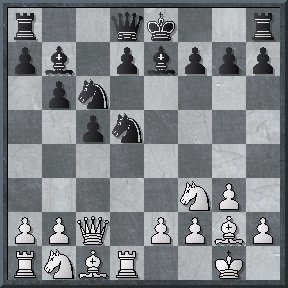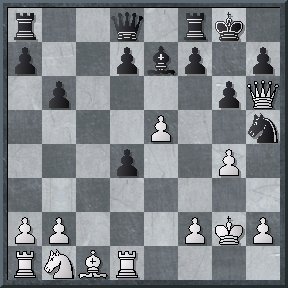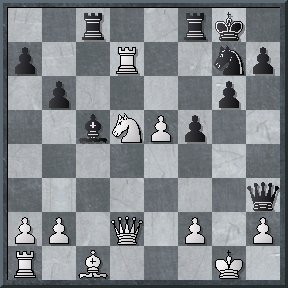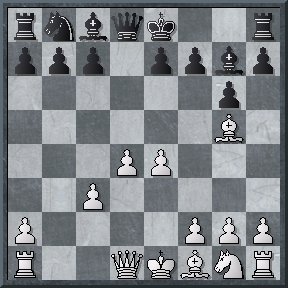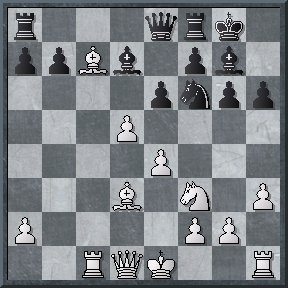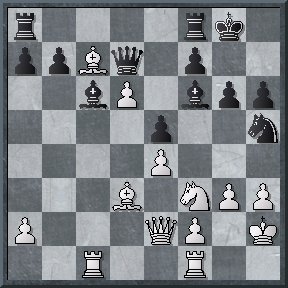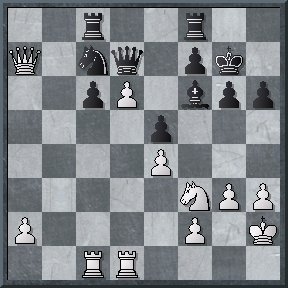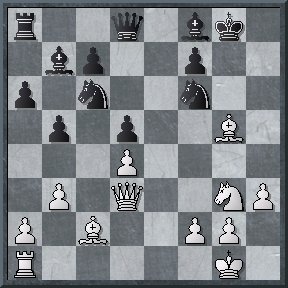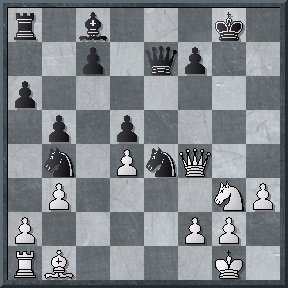12.11.2006
TAL MEMORIAL. GAMES OF ROUND 5 COMMENTED
Round 5 turned out to be a dead drawn day, the fact that hardly anyone could guess, when watching the games.
Aronian,L (2741) - Leko,P (2741) [E15]
Tal Memorial Moscow RUS (5), 11.11.2006
1.d4 ¤f6 2.c4 e6 3.¤f3 b6 4.g3 Ґa6 5.Јc2 c5 6.d5 exd5 7.cxd5 Ґb7 8.Ґg2 White can "lose" a pawn also by 8.e4 Јe7 9.Ґd3 ¤xd5 10.a3 Mamedyarov-Gelfand, Wijk aan Zee 2006 Aronian himself suffered a loss with black in this currently quite promising for white variation. His unlucky try was8...Ґxd5 Gelfand-Aronian, Dortmund 2006. Now he takes white and silently awaits Leko`s reply to the question how black should defend. Looking a bit ahead, we must say the curiosity was satisfied. 8...¤xd5!? 9.0-0 Ґe7 10.¦d1 ¤c6 This is the novelty Leko prepared.
10...Јc8 was tried in Rodshtein-Pashikian, WJun Yerevan 2006 Black solved the opening problems successfully, but white`s play can certainly be improved. 11.Јf5 ¤f6 12.e4 g6 13.Јf4 0-0 14.e5 After the game Leko condemned this move and said he expected the game to continue with14.¤c3 d6 What is important now is that 15.e5 doesn`t work, black has both 14...dxe5 with the idea16.Јh6 (16.¤xe5 Јc8) 16...Јc8 17.¤g5 ¤d4 18.Ґxb7 Јxb7 19.¤ce4 ¤f3+ winning or 15...¤xe5 16.¤xe5 Ґxg2 17.ўxg2 dxe5 18.Јxe5 Јe8 /\19.Ґh6 Јc6+ 14...¤h5 15.Јh6
15.Јg4 d5 16.exd6 Ґxd6 is good for black 15...¤d4!? Very interesting moment. Leko chooses a tricky way that is justified only by a brilliant and unexpected resource on move 18. 15...¦e8!? looks quite good and rather safe for black. Leko reported that his labs analyzed 15...f6 Let us try to sketch a couple of plausible lines: 16.¤h4 Јe8 17.Ґe4 (after 17.¤xg6 Јxg6 18.¦xd7 ¦ad8 19.¦xb7 ¦d1+ 20.Ґf1 black may make draw 20...¦xf1+ 21.ўxf1 Јe4= or may deviate: 20....Јe4 21.¤d2 ¦xf1+ 22.¤xf1 ¤d4) 17...f5 (an alternative is17...¤d8 18.Ґxg6 hxg6 19.¤xg6 ¤g7) 18.Ґd5+ ўh8 19.¤f3 d6 and black is a pawn up in a complicated position. 16.¤xd4 White has no choice: both 16.¦xd4 Ґxf3 (or16...cxd4 17.¤g5 Ґxg5 18.Ґxg5 Јc8!) 17.¦d3 (17.Ґxf3 cxd4 18.Ґxh5 gxh5 19.Јxh5 f6) 17...Ґxg2 18.ўxg2 Јc7 19.g4 Јc6+ and 16.¤g5 ¤e2+ (16...Ґxg5 17.Ґxg5 Јc8) 17.ўf1 Ґxg2+ 18.ўxg2 Ґxg5 19.Ґxg5 f6 leads to a disaster. 16...Ґxg2 17.ўxg2 cxd4 18.g4
Maybe white should have better try to equalize a worse position after 18.¦xd4 Јc7 19.¤c3 but who would refrain from such a move? How can black defend now? Leko asserted after the game that 18.g4 took him aback, but then he remembered how Kramnik used the idea of capturing the queen on h6 against him, and – aha – the solution come as an irradiation... I shall translate from English to English: Peter Leko (anyone heard this name? some associations? "...till the very end", round 3, you remember?) deviated at the board from his home preparation only to miss white`s strong resource 3 moves later. Only a profound belief into piece development in the opening and a pure luck, I`d even say deus ex machina embodied into 18...¦c8!! turned out the guy`s potential blunder into a fine solution...What can I say... "The truth is out there"..."I want to believe". Can anyone introduce me to Gillian, please? 19.¦xd4 White cannot take the knight: 19.gxh5? g5 20.e6 ¦c6 21.¦e1 fxe6 19...¤g7 20.¤c3 After 20.¦d3 move 20...¦c4 deprives white of any h-file hopes. 20...f5 21.Јd2 Ґc5 It deserved attention to play 21...¦c5!? although after 22.¤d5 fxg4 (22...¤e6 23.¤xe7+ Јxe7 24.¦xd7 ¤f4+ 25.ўf1 is by far not winning either) 23.b4 (of course not 23.¦xg4? Јa8) things are not clear in spite of black`s obvious advantage 22.¦xd7 Јh4 23.¤d5?! I think23.ўh1 is much more stubborn, the idea Јd2-h6 helps defending 23...Јxg4+ 23...fxg4 promises nothing but draw: 24.¤f6+ ўh8 (24...¦xf6 doesn`t bring more: 25.exf6 Јxf6 26.Јd5+ ¤e6 27.ўh1! (27.Ґf4) ) 25.b4 Јh3+ 26.ўg1 g3 27.hxg3 Јxg3+ 24.ўf1 Јh3+ 25.ўg1
25...Јg4+ having spent too much time, Leko took a pragmatical decision. 25...¤h5 26.Јg5 (26.Јh6 Јg4+ 27.ўf1 ¦f7) 26...Јg4+ 27.Јxg4 fxg4 brings black some edge, but of course 25...f4! is much stronger, the idea is, for example, ¦f8-f5... If we continue the variation: 26.¤f6+ (26.¤xf4 Ґxf2+ 27.ўxf2 ¦c2!) 26...ўh8 (26...¦xf6 27.exf6 Јg4+) 27.Јxf4 (27.Јd3 f3 28.Јf1 Јh4 /\¦f6 29.ўh1 ¦cd8) 27...¦xf6 28.exf6 Јxd7 29.fxg7+ Јxg7-/+ black`s big advantage becomes obvious. As one of my favourite cartoon characters used to introduce himself, "Hi, I am Corvax. I am clever. I`ve got a computer..." 26.ўf1 Јh3+ 27.ўg1 Јg4+ 1/2-1/2
Now take a look what the modern opening theory is able to. Libretto: two highly combative and creative players are to face each other... Lights off...Silence...The curtain raising...
Carlsen,M (2698) - Shirov,A (2720) C42
Tal Memorial Moscow RUS (5), 11.11.2006
1.e4 e5 2.¤f3 ¤f6 3.¤xe5 d6 4.¤f3 ¤xe4 5.d4 d5 6.Ґd3 Ґd6 7.0-0 0-0 8.¦e1 Ґf5 9.¤c3 This line censors immense cobwebs of drawish chess threads as unbearable for the hearts of those who love chess. ¤xc3 10.bxc3 Ґxd3 11.Јxd3 ¤d7 12.¦b1 After immediate 12.Ґg5 f6 13.Ґh4 ¤b6 14.¤d2 Milman-Ippolito, San Diego 2006 white reached nothing. White tries to provoke b7-b6 first 12...¤b6 12...b6 13.Ґg5 is unpleasant. 13.¤g5 g6 14.Јh3 h5 15.g4 Јd7 16.gxh5 ¦ae8!
17.Ґe3 An endgame with an extra pawn promises white a lot of pain:17.¦xe8 ¦xe8 18.Јxd7 ¦e1+ 19.ўg2 ¤xd7 20.hxg6 fxg6 21.¤f3 ¦d1 22.¦a1 ¤b6 23.Ґb2 ¦xa1 24.Ґxa1 ¤c4 17...Јxh3 18.¤xh3 gxh5 19.Ґf4 After19.Ґh6 Shirov planned 19...¦xe1+ 20.¦xe1 ¦c8 21.Ґf4 Ґxf4 22.¤xf4 c5 and black is Oў 19...ўg7 20.¦xe8 ¦xe8 21.Ґxd6 cxd6 22.¤f4 ўh6
23.ўg2 A rook endgame after 23.¦b5 ¦c8 24.¤xd5 ¤xd5 25.¦xd5 ¦xc3 26.¦xd6+ ўg7 leads to draw; another rook endgame: 23.a4 ¦e4 24.a5 ¦xf4 25.axb6 a6 26.¦a1 still requires some precise moves from black. 23...ўg5 24.ўf3 ¦c8 25.¦b3 ¦c4 26.¦a3 h4 27.h3 White could try 27.¦xa7 ¦xc3+ 28.¤d3 ¦xc2 29.¦xb7 ¤c4 30.¦xf7 ¦xa2 but black`s activity in this simplified position must bring black draw without particular problems. 27...f5 28.¤e6+ ўf6 29.¤f4 ўg5 30.¤e6+ 1/2-1/2
Isn`t the thriller a bit overcensored?
The course of the following game can be described in brief by a quotation from Svidler, who said: "Since some moment people have come to a conclusion that it`s important to put a bishop on g5 against me, and I`ll do all the rest myself." Well, it could have been not that funny...
Ponomariov,R (2703) - Svidler,P (2750) D85
Tal Memorial Moscow RUS (5), 11.11.2006
1.d4 ¤f6 2.c4 g6 3.¤c3 d5 4.cxd5 ¤xd5 5.e4 ¤xc3 6.bxc3 Ґg7 7.Ґg5
7...c5 8.¦c1 cxd4 9.cxd4 0-0 10.¤f3 Ґg4 11.d5 ¤d7 12.Ґe2 ¤f6 13.h3 Ґd7 14.Ґd3 h6 Peter blamed this move of his problems, and recommended 14...Јa5+ 15.Јd2 Јa4 16.¦c4 Јa3 indeed, after 17.0-0 ¦ac8 18.¦d4 ¦c5 19.Ґb1 e6 black has some play. 15.Ґf4 e6 16.Ґc7 Јe8
17.d6 Advantage being on white`s side, it would be clearly unpractical fromhim to go for17.Ґd6 Besides simple 17...exd5 18.e5 ¤e4 19.Ґxf8 ўxf8 20.0-0 Ґc6 black has a promising alternative 17...¤xe4!? That was actually meant by Svidler. Let`s satisfy our curiosity: 18.Ґxe4 (18.Ґxf8 exd5) 18...exd5 (18...Ґa4 19.Ґc2 exd5+ 20.ўf1) 19.Јxd5 ¦d8 20.Јxb7 (20.Ґxf8 Ґb5 21.Јxb7 transposes to one of the lines after 20.Јxb7) 20...Ґb5 21.Ґe7 (21.Ґc7 ¦d7! 22.Јxb5 ¦xc7 23.Јxe8 ¦xc1+ 24.ўd2 ¦xe8 25.¦xc1 ¦xe4 and black has a slight edge; after 21.Ґxf8 Ґxf8 22.a3 f5 black has compensation for the exchange, insofar as white king cannot escape from the center) 21...¦d7 22.Јxb5 ¦xe7 23.Јxe8 ¦fxe8 24.¤d2 f5 25.f3 ¦b8 a strong bishop and activity of the rooks compensate for black a small deficiency of one pawn. 17...Ґc6 18.Јe2 18.¤e5 seems to give white advantage after 18...Ґxe4 (18...Ґa4 19.Јd2 ¤d7 20.¤xd7 Јxd7 21.0-0) 19.Ґxe4 Јb5 20.Ґxb7 (20.¤xg6 ¤xe4!) 20...Јxb7 21.0-0 due to a strong passed pawn. Ponomariov prefers to finish the development before any actions. 18...¤h5 19.g3 e5 20.0-0 Јd7 21.ўh2 Ґf6
22.¦fd1 I have a feeling that this meek move costs white a significant part of the advantage. 22.¦c5 suggested itself black has to defend with 22...¤g7 (after 22...¦fe8 23.Ґb5 the exchange is fatal for black.) 23.¤xe5 Ґxe5 24.¦xe5 ¤e6 Exchange sacrifice here 25.¦xe6! leads to a position with white`s obvious advantage. 22...¤g7 23.Ґc4 ¦ac8 Presumably, after immediate23...¤e6 Svidler had apprehensions about possible sacrifice: 24.Ґxe6 Јxe6 25.¦xc6 bxc6 26.d7 with advantage for white. 24.Ґd5 ¤e6 25.Ґxc6 bxc6 26.Јa6 ¤xc7 27.Јxa7 ўg7
Black cannot unpinat once: 27...Јd8 28.dxc7 Јxc7 29.Јxc7 ¦xc7 30.¦d6 ¤ow after winning a piece back white will be structurally better, but evidently Ponomariov didn`t have enough energy this day. 28.Јb7 Јd8 29.dxc7 Јxc7 30.Јxc7 1/2-1/2
Grischuk demonstrates sad stability.
Grischuk,A (2710) - Mamedyarov,S (2728) C95
Tal Memorial Moscow RUS (5), 11.11.2006
1.e4 e5 2.¤f3 ¤c6 3.Ґb5 a6 4.Ґa4 ¤f6 5.0-0 Ґe7 6.¦e1 b5 7.Ґb3 d6 8.c3 0-0 9.h3 ¤b8 10.d4 ¤bd7 11.¤bd2 Ґb7 12.Ґc2 ¦e8 13.¤f1 Ґf8 14.¤g3 g6 15.b3 d5 16.Ґg5 h6 17.Ґh4 g5 18.¤xg5 hxg5 19.Ґxg5 exd4 20.e5 ¦xe5 21.¦xe5 ¤xe5 22.cxd4 ¤c6 23.Јd3! An important novelty prepared by Grishuk.
23...¤b4 The question whether white is able to reach after 23...Ґe7 more then transposition to Shirov-Mamedyarov by 24.Ґxf6 (24.¤f5 ¤e4) 24...Ґxf6 25.Јh7+ ўf8 26.¤h5 remains open for us, humble chess pigmies. 24.Јf3 Ґe7 24...¤xc2 is losing: 25.Ґxf6 Ґe7 26.Јg4+ ўf8 27.Јg7+ ўe8 28.Ґxe7 and 29.¦c1 25.Ґb1 Ґc8 After 25...¤e4 black position looks dangerous, the direct way allows black to escape with a trick:26.Ґe3! (26.Ґxe7 Јxe7 27.a3 ¤c6 28.¤xe4 dxe4 29.Ґxe4 Јd6 30.¦c1 ¦e8 doesn`t promise white even draw) 26...Јd6 27.a3 ¤c6 28.¤xe4 dxe4 29.Ґxe4 Јf6 30.Јg3+ Јg7 31.Јxc7 ¤xd4!, a1 rook is hanging. 26.Јf4 After the game Mamedyarov said 26.Ґf5!? didn`t scare him much. Did he mean something like "everybody may be afraid, but not everyone gets scared", or what? The consequences look quite disastrous for black: both after 26...¤c6 27.Ґxc8 ¦xc8 28.¤f5 Ґf8 29.¦e1 and 26...Ґe6 27.¦e1 ¤c6 (27...¤e8 28.Ґxe7 Јxe7 29.a3) 28.Ґxf6 Ґxf6 29.¦xe6 fxe6 30.Ґxe6+ ўf8 31.Ґxd5 black is unlikely to save 26...¤e4?! I do not know how to defend, but this move allows a clear solution. 27.Ґxe7 Јxe7
28.a3?! Whitecould finish the game by force: 28.¤xe4! dxe4 29.Ґxe4 c6 30.¦c1! (an important move) Ґe6 (30...Јe6 31.Јg5+ ўf8 32.Јd8+ Јe8 33.Јd6+ ўg7 34.¦c3+-) 31.Јh6 f5 32.¦c3+- 28...¤c6 29.Ґxe4?! Now the win by force is more complicated, yet there is one: 29.¤xe4! dxe4 30.Ґxe4 ¤xd4 (30...Ґd7 31.¦e1+-) 31.Јg3+! (31.Јe3 ¤f5 32.Јd3 Јe5) 31...ўf8 32.Јe3 ¤f5 33.Јf4 Јf6 (33...c6 34.Ґxf5 Јf6 35.¦e1) 34.¦e1! ¦b8 35.Ґxf5 Ґxf5 36.¦e5+- This winning a bishop on a pin in the end of the variation is far from trivial. 29...dxe4 30.¤h5 30.¤xe4 f5 31.¤g3 is just a compensation; 30.¦e1 is strongly met with 30...Јd6 31.Јxe4 Јe6 exchanging the queens. White missed his advantage and makes draw by a perpetual check. 30...Јd6 30...f5 31.Јh6 ¤xd4 led to a draw by a perpetual anyway. 31.¤f6+ ўf8 32.Јh6+ ўe7 33.¤g8+ ўe8 34.¤f6+ ўe7 1/2-1/2
Well, let`s wish to Grischuk to get his royal-flush in on of the remaining games.
The game Gelfand-morozevich right from the opening simplified to a technical position that didn`t change essentially till the very end of the game. I think after the fights we saw the game can be skipped

